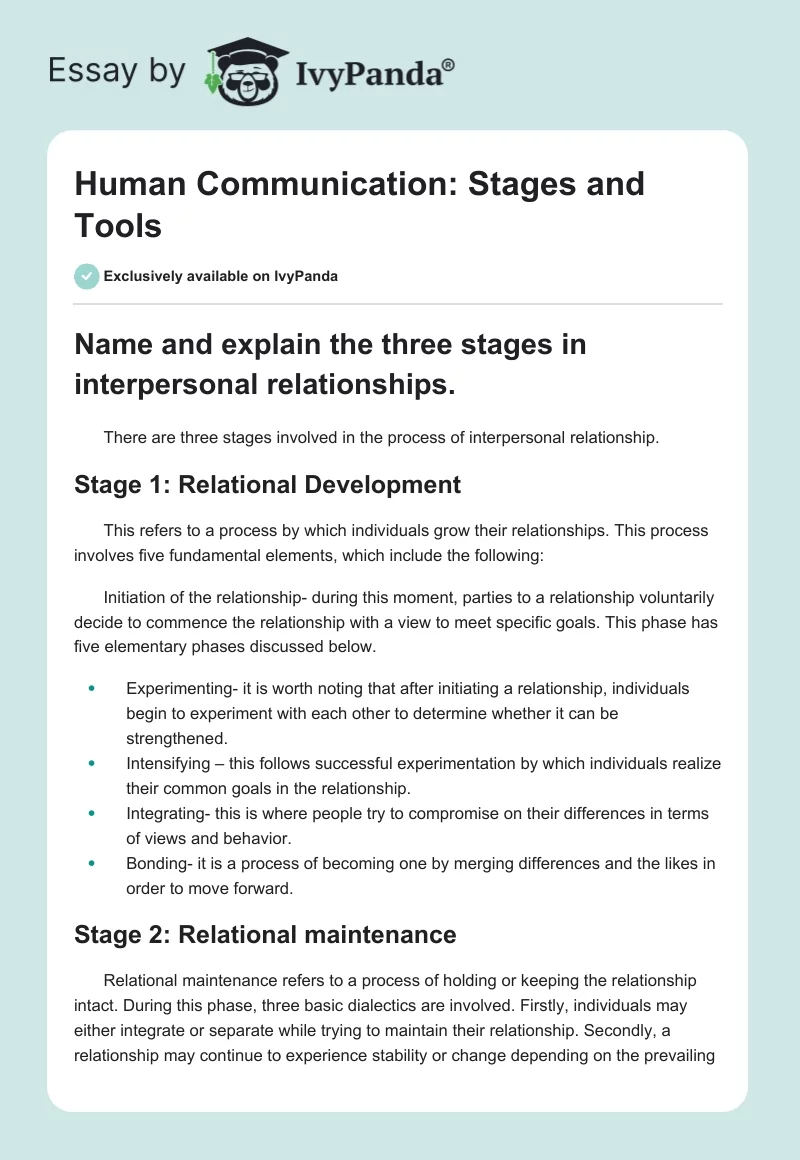Name and explain the three stages in interpersonal relationships.
There are three stages involved in the process of interpersonal relationship.
Stage 1: Relational Development
This refers to a process by which individuals grow their relationships. This process involves five fundamental elements, which include the following:
Initiation of the relationship- during this moment, parties to a relationship voluntarily decide to commence the relationship with a view to meet specific goals. This phase has five elementary phases discussed below.
- Experimenting- it is worth noting that after initiating a relationship, individuals begin to experiment with each other to determine whether it can be strengthened.
- Intensifying – this follows successful experimentation by which individuals realize their common goals in the relationship.
- Integrating- this is where people try to compromise on their differences in terms of views and behavior.
- Bonding- it is a process of becoming one by merging differences and the likes in order to move forward.
Stage 2: Relational maintenance
Relational maintenance refers to a process of holding or keeping the relationship intact. During this phase, three basic dialectics are involved. Firstly, individuals may either integrate or separate while trying to maintain their relationship. Secondly, a relationship may continue to experience stability or change depending on the prevailing circumstances. Lastly, in pursuit of keeping the relationship intact, a party or parties may freely express their views and character or conceal certain elements of their relationship (Pearson, Nelson, Titsworth, and Harter 20).
Stage 3: Relational deterioration
As the title suggests, relationships disintegrate during this moment. This stage involves five elements that may occur during the deterioration. They include differentiation, circumscribing, stagnating, avoidance, and termination.
Discuss two examples of how technology can be used to facilitate small-group communication
As we experience technological advancements, groups will benefit by facilitating their communication without meeting face-to-face. Two ways through which small groups may benefit from the technology include teleconferencing and online computer texting.
Teleconferencing
This is a communication process by which members of a group communicate via telephone. Small groups can utilize this technology to conduct discussions where members cannot meet face-to-face.
Computer-based texting
In this process, groups hold online discussions via internet connectivity by a process. Although organizations that initiated telephoning technology in their communication have raised issues of costs, it is worth noting that computer-based testing and online group chats are relatively cheap. This method serves to remedy those members of a group who find it difficult to assemble with a view to discuss matters of a group. Research has shown that online discussions within groups enhance collaborative learning. In recent studies, researchers in communication suggest that students that actively involved in the online based discussions obtained higher marks as compared to non-participants.
Explain how organizational images are created through public relations and crisis management efforts
The concept of organizational image has received emphasis from in the mainstream organizational setting. Researchers have documented evidence that there is a significant correlation between organizational image and public relations (Pearson, Nelson, Titsworth, and Harter 15). This means that organizations doing well in terms of building good public relations out-performed those lagging behind with respect to their public relations.
Although many companies undertake to develop their strong public image as a strategic effort, evidence suggests that these efforts heighten when crises.
Organizations aim to create strong images through the establishment of corporate social responsibility (CSR) plans. This takes the form of involving in community development via charities and sponsorships aimed at improving the statuses of communities within which they operate.
Similarly, during crisis, organizations begin to model themselves in order to be associated with solutions to the underlying crises. In so doing, management pursues this effort with an objective to build an image of goodwill and responsiveness to the community through the provision of funds. Examples of crises that organizations have used as a platform for image improvement include environmental conservation, educational funding, and charitable contributions to the deprived individuals.
Work Cited
Pearson, Judy, Paul Nelson, Scott Titsworth, and Lynn Harter. Human Communication with Learning Tool Suite. New York: McGraw Hill, 2006. Print.


